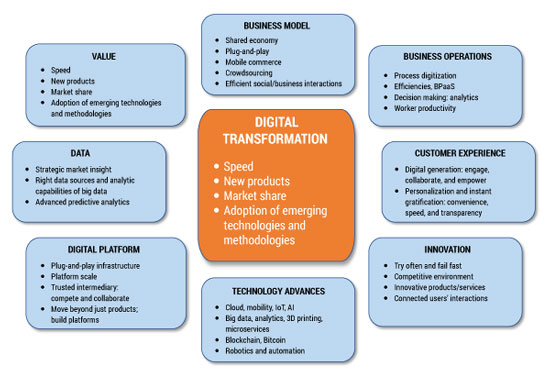Digital experiences have become a standard part of daily life. Leading companies recognize that digital disruption presents multiple growth opportunities, including delighting their customers with convenience and personalization, leveraging the wealth of data trails from digital activity to get even closer to the customer, and using technology to operate faster and better.
The digital business trend is driven by many factors, including technological advances, emerging business models, increasing customer expectations, and the will to retain market leadership. Disruptive innovations are interrupting businesses continuously in almost every sector, and everyone seems to be in a race to become the leader of their own industry.
Figure 1 provides a quick overview of the leading drivers influencing the next wave of innovation and digital businesses. To be successful with digital transformation, organizations need to understand these drivers properly and develop and execute on a holistic, integrated strategic plan addressing the needs of the business.

Figure 1 — Key drivers impacting businesses and encouraging digital transformation.
Technology Advances
Over the past couple of decades, technologies have advanced and become ready for industrial use at an unprecedented rate, impacting all aspects of business. Organizations are actively considering technologies like artificial intelligence (AI), the Internet of Things (IoT), cloud, 3D printing, predictive analytics, computer vision, and others for the solutions they are envisioning. For example, smart cities solutions rely on IoT, analytics, and AI; self-driving cars leverage sensors, computer vision, robotics, and AI; and digital healthcare and artificial limbs depend heavily on AI, analytics, and 3D and 4D printers. Leveraging these technology advances requires an integrated, holistic plan to achieve optimal benefits.
We’re now in the midst of an ongoing emergence of revolutionary technologies such as blockchain, Bitcoin, microservices, APIs, and so on, each one quite capable of transforming an existing industry or creating a new one. Consider blockchain, which is an open distributed ledger that can record transactions between two parties efficiently and in a verifiable and permanent way. The ledger itself can also be programmed to trigger transactions automatically. Over half of respondents to a recent Cutter survey are exploring blockchain to exploit its financial transaction management capabilities. One accounting firm, EY Switzerland, has provided digital wallets to all of its employees, has installed a Bitcoin ATM in its office in Zurich, and accepts Bitcoin as payment for all its consulting services. Companies such as Netflix believe that speed is key to winning in the marketplace and are adopting technologies like microservices, APIs, and DevOps to achieve the required speed and replace silos with microservices teams.
Business Model
With these technology advances, new business models such as shared services (e.g., Uber, Airbnb), mobile banking (e.g., payments, funds transfers, remote deposits), and crowdsourcing (e.g., Be My Eyes, IdeaConnection) have matured and become viable. Other disruptive business models include:
- App-only banks with no branch offices but higher returns
- Healthcare plans that use high-tech screening and wellness tools to deliver health services for US $149/month with no limits or deductibles
- Robots that can “walk” a farmer’s crops looking for pests
- Digital government initiatives that use emerging technologies to improve citizen services
The advent of new business models and supporting technologies has opened new business opportunities that individuals and companies — from startups to large established firms — can pursue. Companies are not only reengineering and optimizing their business processes to leverage new technologies, they are also transforming how these processes interact with each other within the company and between involved partners.
Business Operations
Customer experience is arguably the first change observers will notice as a result of digital transformation, but it is just one part of digital transformation, albeit a highly visible one. Other parts of the transformation are generally hidden behind the scenes, but they are as critical as customer experience. Businesses are getting big paybacks from digitization of internal processes, which enhances employee productivity and overall performance. Leveraging automation and process digitization enables the delivery of business processes as a service (BPaaS), as well as self-service for standard functions like HR-related tasks. Collaborative tools allow for virtual teams, thereby removing the limitation of physical offices and facilitating more active participation by all. These capabilities are critical for the bottom line in terms of overall speed, throughput, profit, company reputation, and growing revenue from digital business.
Digital Platform
With digital business, the distinction between partners and rivals is being blurred, and businesses need to develop a keen understanding of all the different relationships that might exist between firms in their orbit and how they might cooperate and/or compete with them. It is quite possible to compete with a company for one business opportunity while cooperating with them on another, resulting in what has been called “coopetition.” For example, within the entertainment (television) industry, HBO competes with Netflix (as it does with Showtime) for programming market share, but it collaborates with Netflix to have leverage against distribution channels such as Comcast and Amazon.
Firms should focus on developing effective digital platforms and becoming trusted intermediaries that can bring competing businesses together. Some fast-growing companies like Facebook, Apple, Uber, and Airbnb are leveraging digital platforms for business growth. These businesses have created an open, participative, plug-and-play infrastructure that allows both consumers and producers to collaborate and work together effectively, enhancing overall business value.
Data Analytics
In today’s digital world, it is critical to assemble the right data and turn it into strategic assets to make timely decisions for business and customer interactions. Most probably, this will require collaboration not just within an organization but with partners as well. As part of a data strategy, we need to consider data sources, analytical capabilities of big data, the role of data-driven decision making, and risks around data privacy and security.
Customer Experience
We are living in an experience-based economy without traditional loyalty to brand or company. Irrespective of industry, one common competitive advantage is the customer experience you offer. A high level of differentiated experience enables market leadership (think Amazon in retail, or Netflix in entertainment) and a premium price position. Providing a great customer experience requires a good understanding of your customers and the digitization of customer touchpoints.
Businesses are building their analytics capability to understand customers in more detail. For example, insurance companies are improving their portfolios and cost structures through analytics-based underwriting and pricing and using technology to enhance in-person sales conversations.
Innovation
Today’s emerging companies are born digital. They can change — and change fast — to answer consumer demand or a competitive offering. So how can an enterprise win at digital? I believe the answer lies in digital transformation and the innovative solutions you develop as part of it.
[For more from the author on this topic, see “Disrupt or Be Disrupted: The Digital Business Imperative.”]


